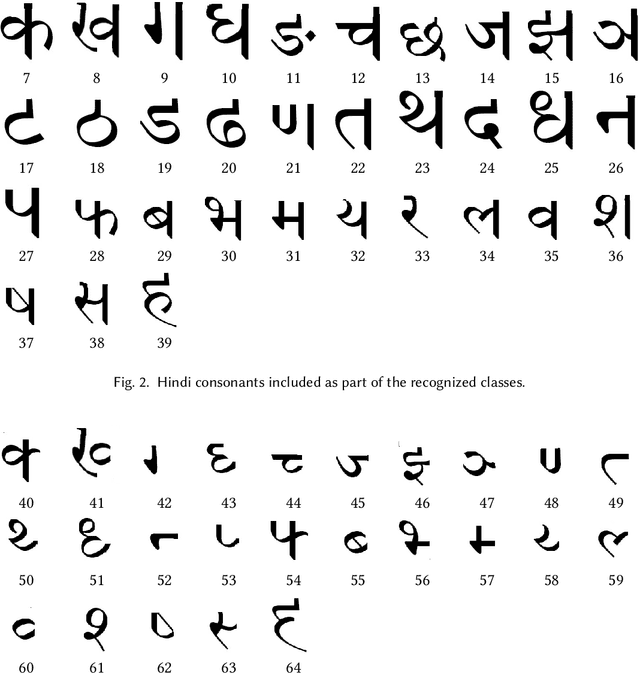Anand Sharma
MIET, Meerut
A Classifier Using Global Character Level and Local Sub-unit Level Features for Hindi Online Handwritten Character Recognition
Oct 26, 2023



Abstract:A classifier is developed that defines a joint distribution of global character features, number of sub-units and local sub-unit features to model Hindi online handwritten characters. The classifier uses latent variables to model the structure of sub-units. The classifier uses histograms of points, orientations, and dynamics of orientations (HPOD) features to represent characters at global character level and local sub-unit level and is independent of character stroke order and stroke direction variations. The parameters of the classifier is estimated using maximum likelihood method. Different classifiers and features used in other studies are considered in this study for classification performance comparison with the developed classifier. The classifiers considered are Second Order Statistics (SOS), Sub-space (SS), Fisher Discriminant (FD), Feedforward Neural Network (FFN) and Support Vector Machines (SVM) and the features considered are Spatio Temporal (ST), Discrete Fourier Transform (DFT), Discrete Cosine Transform (SCT), Discrete Wavelet Transform (DWT), Spatial (SP) and Histograms of Oriented Gradients (HOG). Hindi character datasets used for training and testing the developed classifier consist of samples of handwritten characters from 96 different character classes. There are 12832 samples with an average of 133 samples per character class in the training set and 2821 samples with an average of 29 samples per character class in the testing set. The developed classifier has the highest accuracy of 93.5\% on the testing set compared to that of the classifiers trained on different features extracted from the same training set and evaluated on the same testing set considered in this study.
Structural analysis of Hindi online handwritten characters for character recognition
Oct 12, 2023Abstract:Direction properties of online strokes are used to analyze them in terms of homogeneous regions or sub-strokes with points satisfying common geometric properties. Such sub-strokes are called sub-units. These properties are used to extract sub-units from Hindi ideal online characters. These properties along with some heuristics are used to extract sub-units from Hindi online handwritten characters.\\ A method is developed to extract point stroke, clockwise curve stroke, counter-clockwise curve stroke and loop stroke segments as sub-units from Hindi online handwritten characters. These extracted sub-units are close in structure to the sub-units of the corresponding Hindi online ideal characters.\\ Importance of local representation of online handwritten characters in terms of sub-units is assessed by training a classifier with sub-unit level local and character level global features extracted from characters for character recognition. The classifier has the recognition accuracy of 93.5\% on the testing set. This accuracy is the highest when compared with that of the classifiers trained only with global features extracted from characters in the same training set and evaluated on the same testing set.\\ Sub-unit extraction algorithm and the sub-unit based character classifier are tested on Hindi online handwritten character dataset. This dataset consists of samples from 96 different characters. There are 12832 and 2821 samples in the training and testing sets, respectively.
Histograms of Points, Orientations, and Dynamics of Orientations Features for Hindi Online Handwritten Character Recognition
Sep 05, 2023Abstract:A set of features independent of character stroke direction and order variations is proposed for online handwritten character recognition. A method is developed that maps features like co-ordinates of points, orientations of strokes at points, and dynamics of orientations of strokes at points spatially as a function of co-ordinate values of the points and computes histograms of these features from different regions in the spatial map. Different features like spatio-temporal, discrete Fourier transform, discrete cosine transform, discrete wavelet transform, spatial, and histograms of oriented gradients used in other studies for training classifiers for character recognition are considered. The classifier chosen for classification performance comparison, when trained with different features, is support vector machines (SVM). The character datasets used for training and testing the classifiers consist of online handwritten samples of 96 different Hindi characters. There are 12832 and 2821 samples in training and testing datasets, respectively. SVM classifiers trained with the proposed features has the highest classification accuracy of 92.9\% when compared to the performances of SVM classifiers trained with the other features and tested on the same testing dataset. Therefore, the proposed features have better character discriminative capability than the other features considered for comparison.
 Add to Chrome
Add to Chrome Add to Firefox
Add to Firefox Add to Edge
Add to Edge